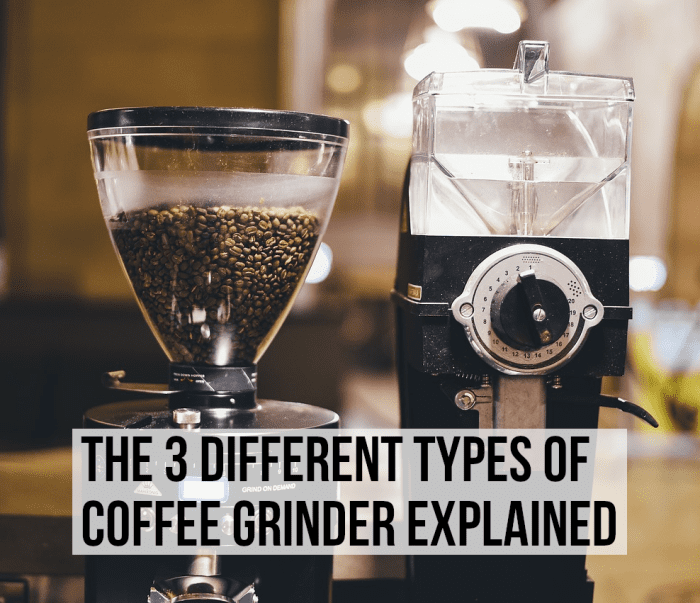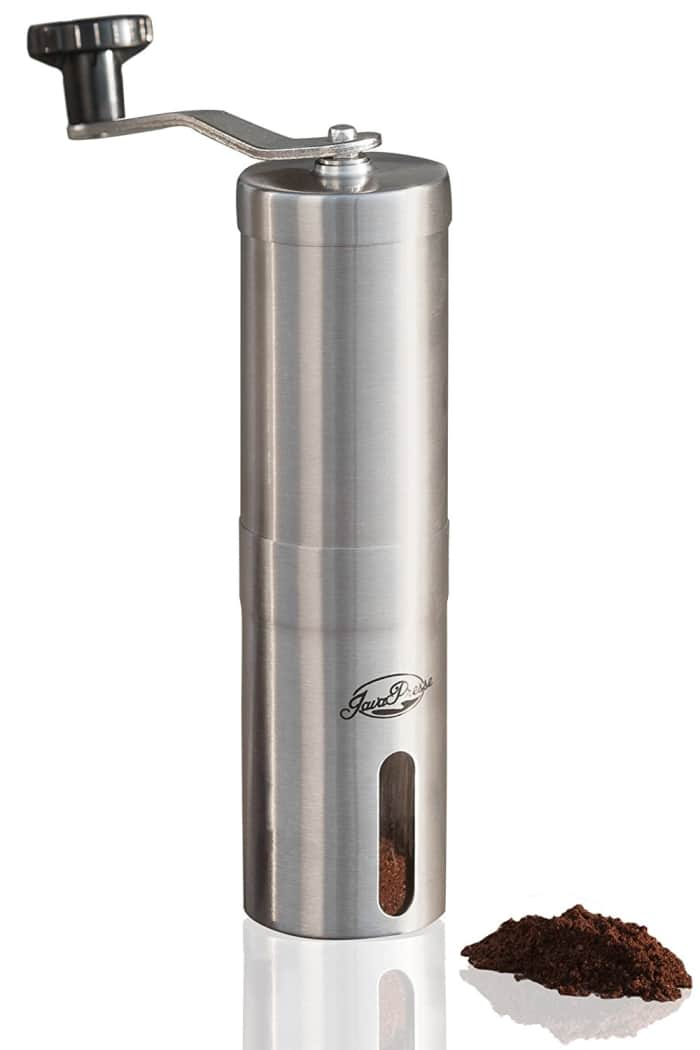Blade vs. Burr vs. Manual: The Complete Coffee Grinder Guide
Paul's passion for making and consuming coffee extends back over thirty years. An extensive traveler, he currently lives in Florida.
What Are the Different Types of Coffee Grinders?
As a passionate drinker and consumer of coffee for over 30 years, I can say for certain that grinding your own coffee—rather than buying it ready ground—is one of the easiest ways to achieve superior beverages.
For those people who have little or no experience with the different types of grinder, the variety of products on sale can be confusing—expressions such as blade or burr meaning nothing to the average person.
The Three Main Types of Coffee Grinder
- Blade grinders
- Burr grinders (two main subcategories: wheel and conical)
- Manual grinders
I will discuss which types are considered the most accurate, which are considered the messiest, which are considered the quietest. Last but not least, I will cover which types of grinder are generally the cheapest and which tend to be more expensive.
I will also give examples of specific models on the market that I can personally recommend.

The blades of my Krups F203 viewed from above. The blade spins like a propeller to slice the beans repeatedly reducing them to grounds. The longer the blade spins, the finer the resulting grounds will result.
Self
1. Blade Grinders
Blade grinders are generally the most inexpensive type of coffee grinder.
As their name suggests, they use a blade to cut up the coffee beans. The blade spins very quickly and looks a like a propeller. It slices the beans into smaller and smaller pieces.
The fineness of the ground coffee is controlled by the length of time that you grind the coffee beans for. This makes them less precise than burr machines, as uneven sized coffee grounds can result, giving a slightly less consistent drink quality.
The heat generated by the rapidly revolving blades can also affect the taste.
These machines are also relatively noisy, when compared with burr and manual grinders.
If you just want something straightforward for a low cost that does the job and doesn't take up much space, this type of grinder will satisfy the majority of coffee lovers. They are excellent for small kitchens and office spaces.

The KRUPS F203 electric blade grinder. I use one of these in my office area. Blade grinders are usually more affordable than burr grinders, but they tend to be noisier, and less precise. The grinding process involves a spinning, slicing blade .
Self
My Favorite Affordable Blade Grinder: The Krups F203
I use a Krups F203 in my home office. They are ideal for a small kitchen or work area. I would also recommend a Krups for coffee lovers on a tight budget.
Advantages
- Inexpensive
- Don't take up much space.
- The 200-watt motor is fast and gives you a quick grind.
- You can use the Krups for spices, herbs, nuts, as well as coffee.
- Easy to clean.
- Reliable, tough and long-lasting in my experience.
Disadvantages
- Noisy. If someone is sleeping nearby, it will awaken them.
- Relatively messy when compared to my burr grinder.
- The fineness of the grind depends on how long you press down. It takes some experience to learn the required optimum for your coffee maker. For example, espresso makers require very fine grounds and French presses need much coarser.

A burr grinder interior. The bean hopper, which sits on top, has been removed in order to see inside. The coffee beans are crushed and torn, rather than chopped, meaning that very little heat is generated.
2. Burr Grinders
This type of grinder works by crushing the coffee beans against a static surface with a grinder wheel. The coarseness/fineness of the coffee grounds is set by the position of the burr.
This effectively means that you can dictate the size of the coffee grounds much more accurately and consistently than with a blade grinder.
Burr grinders typically have multiple settings, allowing you to choose the appropriate coarseness required for your coffee maker.
There are two main types of burr grinder: those with flat grinder wheels and those with conical grinder wheels.
Wheel Burr Grinders
This type generally costs the least out of the two.
They have two main downsides when compared to conical burr machines, however. The first one being that they can be loud, due to the wheel, which rotates extremely quickly; and the second problem is that they are relatively messy.
They are still generally superior to blade grinders in most respects, however.
Conical Burr Grinders
Conical burr grinders are generally accepted to be the best type of grinder available, but they are also the most expensive.
Because they can work at a slower speed, you don't get the heat problems that you can get with a blade machine.
They don’t create as much noise as wheel burr grinders and make less mess, as the grinder doesn’t need to work as fast.
You can also grind oilier coffee beans without worrying so much about clogging up your machine, which can be an issue with other types of grinder.

My own Capresso Infinity. After going through numerous grinders, I settled on this one. Quiet and accurate, its conical burrs do their job accurately and efficiently. After over six years, I've had virtually zero issues with this machine.
Self
My Favorite Affordable Burr Grinder: The Capresso 560.01 Infinity
This Capresso model is the main grinder that I use on a day to day basis. Unlike some of the other grinders I've owned or used, this machine has shown itself to be a reliable and efficient performer over time.
Advantages
- 16 grind settings, so if you drink different styles of coffee like me, it's easy to use.
- The built-in timer is very straightforward.
- Advanced and long-lasting conical burrs.
- Quiet compared to most other motorized machines.
- The bean hopper is big enough to handle up to 8-1/2 ounces of beans, more than enough for any situation I've encountered.
- Reasonably priced.
Disadvantages
- Fiddly to clean inside and out. I have the black version, but would buy the stainless steel version if I had another choice, both for the sake of appearance and for cleaning the outside.
- The black dot used to set the coarseness was never easy to see at a glance, but now has faded over time making it harder to tell the setting.
- Some grounds tend to get retained then spill out onto the counter.
Blade vs. Burr: A Summary of The Differences
| Attribute | Blade Grinder | Burr Grinder |
|---|---|---|
Accuracy | Moderate | Excellent |
Messiness | High | Moderate |
Loudness | Noisy | Quiet |
Expense | Inexpensive | Pricier |

A disassembled JavaPresse showing the individual components. Manual grinders come in all shapes and sizes. Almost all are operated with a crank, which means that they don't require a power source and are very quiet.
3. Manual Grinders
Most modern types of burr grinder are electrically powered, but there are also some manual grinders available on the market.
These types of grinder generally work by the operator turning a crank. The size of the grounds is dictated by how long you grind for.
There are a number of advantages with owning a manual grinder. Firstly you don't need a power source, so you can use them outdoors, or when traveling. They are also very quiet to operate and often relatively inexpensive to buy.
Manual grinders can also look more attractive than their electrical counterparts, especially those with a vintage or exotic design, and can make a good talking point at social events.
My Favorite Affordable Manual Grinder: The JavaPresse
The sleek and sexy JavaPresse is my chosen grinder for travelling, hiking, or outdoors. It is head and shoulders above the average manual grinder and it doesn't cost the earth to buy.
Advantages
- Looks beautiful.
- No power source or batteries needed, so you can use it anywhere you go.
- Unlike many more basic manuals, there are click settings so that it's easy to get the right coarseness of grounds for your coffee maker.
- No motor so it's quiet.
- The burrs last longer than blades.
Disadvantages
- More expensive than many other manual grinders on the market.
- Grinding is time-consuming compared to an electric.
- Not the easiest grinder to clean.
© 2011 Paul Goodman
Comments
April Starrs from Sydney on July 23, 2017:
You will never get good coffee using a blade grinder since the grind size is too inconsistent and it generates too much heat so dries out the coffee. It's burrs or nothing for me.

















